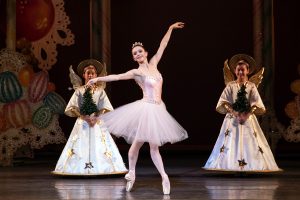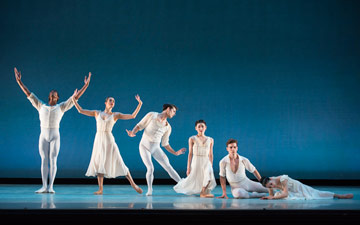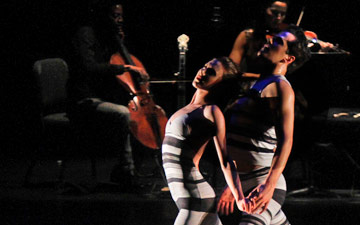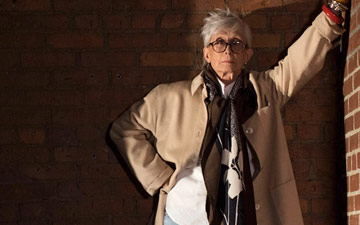
The Washington Ballet
Twyla Tharp – All American: Push Comes to Shove|Surfer at the River Styx|Nine Sinatra Songs
Washington, Kennedy Center Eisenhower Theater
22-26 February 2012
www.washingtonballet.org
Twyla Tharp is a choreographer for all seasons. With a phenomenal career spanning nearly five decades, she is one of the most acclaimed dancemakers in America. Known for her signature idiom, which combines classical ballet, jazz, and modern dance and blends them together with a quirky and humorous style, Tharp has accomplished a great deal: she choreographed nearly 140 dances, working with prominent ballet and modern dance companies, including American Ballet Theatre (ABT), New York City Ballet, and The Paris Opera Ballet, created dances for five Hollywood movies and directed and choreographed four Broadway shows, including the recent Sinatra-inspired Come Fly Away.
With its new program titled Twyla Tharp: All American, the Washington Ballet paid homage to the high priestess of American dance. Presented at the Kennedy Center Eisenhower Theater in February, the triple bill included some of Tharp’s most popular works: the witty Push Comes to Shove, the mysterious Surfer at the River Styx, and the timeless Nine Sinatra Songs.
A high-energy vaudevillian romp, Push Comes to Shove opened the program on a gleeful note. The piece is set to a curious musical pairing of Joseph Lamb’s Bohemia Rag 1919 with Haydn’s Symphony 82 in C Major and exemplifies Tharp’s unmistakable movement idiom, spiced with rhythmic ingenuity and engaging wit.
At the time of its premier, Push Comes to Shove was called “groundbreaking,” and with good reason: it was one of the first “crossover” ballets, where Tharp integrated classical and modern movements as no-one had done before. The piece was created in 1976 for ABT and the leading male role was tailor-made for the one and only Mikhail Baryshnikov. (Time Magazine called the premiere “the most important dance event of the year.”)
More than three decades later, Push has clearly lost its edge, yet as the Washington Ballet demonstrated during the Sunday matinee performance, the dance didn’t lose its power to provide good fun and make an audience smile.
Dressed in a bowler hat and copper-colored costume, the agile Jared Nelson, in the Baryshnikov role, leaped and joked his way through Tharp’s frenetic steps with an unflinching confidence, never failing to look suave and sassy. His character – part clown, part virtuoso classical ballet dancer – is a hard act to pull off, yet Nelson nailed the comic and technical demands of the role in a performance that was entertaining and charming in the most delightful ways. Emily Ellis and Morgann Rose, in the central ballerina roles as two rivals competing for the hero’s attention, portrayed their characters to a highly amusing theatrical effect. The corps de ballet was in its element as well – the excellent cast eagerly embraced Tharp’s propulsive style and never let go.

The centerpiece of the program, Surfer at the River Styx – a relentless tour de force of sound and movement – held the audience on the edge of their seats for nearly the entire duration of the dance. The combined power of the choreography and music was truly overwhelming.
Choreographed as a sextet (two male soloists flanked by four supporting dancers), Surfer reenacts the crossing of the mystical River Styx, which in Greek mythology separates the world of the living from the world of the dead. The piece is set to a score of thunderous intensity and exceptional beauty by Donald Knaack.
Knaack, a conservatory-trained percussionist who names John Cage as his major creative influence, composes unconventional percussive music for “found” instruments. In his welcoming speech, Septime Webre, artistic director of the Washington Ballet, invited the audience to take a look inside the orchestra pit during the intermission, where Knaack, who performed live during the show, assembled his unique junk instruments: cans, bottles, plastic containers, hubcaps, pots and pans, chimes made of hundreds of door keys, and so on, all neatly arranged in rows and stacks. The sight of this so-called orchestra was something to remember!
In the stark and ominous Surfer, Tharp’s frenzied movements combined with Knaack’s pulsating percussion brought forth a breathtaking display of high-velocity dancing. As the music was building up one powerful crescendo after another, Corey Landolt as the Surfer and Jonathan Jordan as his alter ego were fighting their way into the unknown, spinning and leaping through the darkness of the stage. Both dancers, who acted in the piece as rivals, proved themselves to be impressive dynamos with virtuosity to burn. They darted across the stage at a thunderous speed, as if possessed by demons. Their tormentors, personified by the supporting quartet, were the guardians of the underworld, whose task was to impede the travelers’ quest. In the end, after the grueling marathon of nonstop dancing and drumming, the movements and music (additional score by David Kahne) suddenly surrendered to a languid apotheosis, transporting the dancers and the audience into a state of a luminous tranquility.
The concluding Nine Sinatra Songs provided a welcome respite for the ears and a visual feast for the eyes.
Tharp has a longstanding relationship with the music of Frank Sinatra. She deeply admired Sinatra’s special gift to create dramatic characters with his voice and his ability to relate the emotions of love and heartbreak in his songs. In Nine Sinatra Songs, the choreographer turned the late crooner’s famous love ballads into an exuberant and sensuous dance showcase for seven couples, exploring the ups and downs of their relationships in a glamorous ballroom setting. It became Tharp’s most successful and admired work, her ultimate hit.

With its dazzling choreography and impressive scenic designs by Santo Loquasto, Nine Sinatra Songs never ceases to entertain. The music itself makes the heart sing with joy. High points of the performance were Sona Kharatian and Luis R. Torres in the athletic One for My Baby. Dancing with jarring intensity and still looking absolutely dashing, the couple brought a hint of Hollywood glamour into their passionate encounter. Morgann Rose and Jonathan Jordan were all smiles in the jaunty Forget Domani, their technique effortless and sharp. The best moment of the performance, however, came at the end, when the entire ensemble joined forces in My Way, offering the audience a stunning display of spectacular dancing and Oscar de la Renta fashion and giving this fine program a grand finish.

















You must be logged in to post a comment.